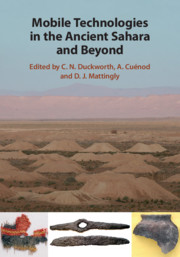Book contents
- Mobile Technologies in the Ancient Sahara and Beyond
- The Trans-Saharan Archaeology Series
- Mobile Technologies in the Ancient Sahara and Beyond
- Copyright page
- Contents
- Figures
- Tables
- Contributors
- Preface
- Part I Introduction
- Part II Technological Mobility and Transfers
- 2 Technological Innovations Transfer through the Hyper-Arid Belt
- 3 The Diffusion of Irrigation Technologies in the Sahara in Antiquity
- 4 Crafts in Roman North Africa
- 5 Movement and Management of Animals in the North and West of Africa from 1000 BC to AD 1000
- 6 The Early History of Weaving in West Africa
- Part III Metallurgy
- Part IV Glass Technology
- Part V Handmade Pottery
- Part VI Conclusion
- Index
- References
5 - Movement and Management of Animals in the North and West of Africa from 1000 BC to AD 1000
from Part II - Technological Mobility and Transfers
Published online by Cambridge University Press: 18 September 2020
- Mobile Technologies in the Ancient Sahara and Beyond
- The Trans-Saharan Archaeology Series
- Mobile Technologies in the Ancient Sahara and Beyond
- Copyright page
- Contents
- Figures
- Tables
- Contributors
- Preface
- Part I Introduction
- Part II Technological Mobility and Transfers
- 2 Technological Innovations Transfer through the Hyper-Arid Belt
- 3 The Diffusion of Irrigation Technologies in the Sahara in Antiquity
- 4 Crafts in Roman North Africa
- 5 Movement and Management of Animals in the North and West of Africa from 1000 BC to AD 1000
- 6 The Early History of Weaving in West Africa
- Part III Metallurgy
- Part IV Glass Technology
- Part V Handmade Pottery
- Part VI Conclusion
- Index
- References
Summary
This chapter explores the movement and introduction (translocation) of domestic animal species and some factors relevant to the transference of knowledge and skills associated with their husbandry between the first millennium BC and AD 1500 across the Trans-Saharan zone. Although animal products were traded widely in these regions, live animal movement and husbandry is the main material focus of this work. It reviews the process of animal translocation, considers the impacts associated with the process of moving species, provides evidence for species introductions in these regions and discusses how populations may have encountered and shaped various forms of animal husbandry. Other relevant aspects such as husbandry requirements, feeding strategies, mobility and human perceptions of animal species are also considered. To some extent, these introductions and technological changes are evident in the presence and relative frequencies of domesticate species; these are presented and interpreted to the extent which the data permits. By contextualising the Sahara within patterns of North African and sub-Saharan animal husbandry, the chapter aims to go beyond statements regarding the dates by which species were introduced at individual sites, and contribute to a fuller understanding of the ways in which animals and the techniques used to manage them moved.
- Type
- Chapter
- Information
- Mobile Technologies in the Ancient Sahara and Beyond , pp. 143 - 182Publisher: Cambridge University PressPrint publication year: 2020
References
- 1
- Cited by



